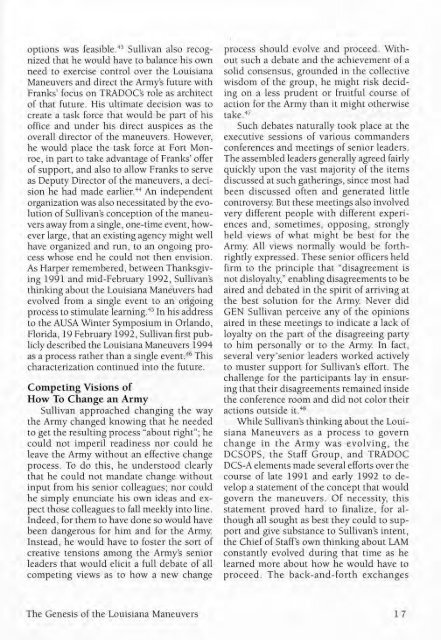The Modern Louisiana Maneuvers - US Army Center Of Military History
The Modern Louisiana Maneuvers - US Army Center Of Military History
The Modern Louisiana Maneuvers - US Army Center Of Military History
Create successful ePaper yourself
Turn your PDF publications into a flip-book with our unique Google optimized e-Paper software.
options was feasible .43 Sullivan also recognized<br />
that he would have to balance his own<br />
need to exercise control over the <strong>Louisiana</strong><br />
<strong>Maneuvers</strong> and direct the <strong>Army</strong>'s future with<br />
Franks' focus on TRADOCs role as architect<br />
of that future. His ultimate decision was to<br />
create a task force that would be part of his<br />
office and under his direct auspices as the<br />
overall director of the maneuvers. However,<br />
he would place the task force at Fort Monroe,<br />
in part to take advantage of Franks' offer<br />
of support, and also to allow Franks to serve<br />
as Deputy Director of the maneuvers, a decision<br />
he had made earlier. 44 An independent<br />
organization was also necessitated by the evolution<br />
of Sullivan's conception of the maneuvers<br />
away from a single, one-time event, however<br />
large, that an existing agency might well<br />
have organized and run, to an ongoing process<br />
whose end he could not then envision.<br />
As Harper remembered, between Thanksgiving<br />
1991 'and mid-February 1992, Sullivan's<br />
thinking about the <strong>Louisiana</strong> <strong>Maneuvers</strong> had<br />
evolved from a single event to an ortgoing<br />
process to stimulate learning. 45 In his address<br />
to the A<strong>US</strong>A Winter Symposium in Orlando,<br />
Florida, 19 February 1992, Sullivan first publicly<br />
described the <strong>Louisiana</strong> <strong>Maneuvers</strong> 1994<br />
as a process rather than a single event.46 This<br />
characterization continued into the future.<br />
Competing Visions of<br />
How To Change an <strong>Army</strong><br />
Sullivan approached changing the way<br />
the <strong>Army</strong> changed knowing that he needed<br />
to get the resulting process "about right"; he<br />
could not imperil readiness nor could he<br />
leave the <strong>Army</strong> without an effective change<br />
process. To do this, he understood clearly<br />
that he could not mandate change without<br />
input from his senior colleagues; nor could<br />
he simply enunciate his own ideas and expect<br />
those colleagues to fall meekly into line.<br />
Indeed, for them to have done so would have<br />
been dangerous for him and for the <strong>Army</strong>.<br />
Instead, he would have to foster the sort of<br />
creative tensions among the <strong>Army</strong>'s senior<br />
leaders that would elicit a full debate of all<br />
competing views as to how a new change<br />
<strong>The</strong> Genesis of the <strong>Louisiana</strong> <strong>Maneuvers</strong><br />
process should evolve and proceed. Without<br />
such a debate and the achievement of a<br />
solid consensus, grounded in the collective<br />
wisdom of the group, he might risk deciding<br />
on a less prudent or fruitful course of<br />
action for the <strong>Army</strong> than it might otherwise<br />
take. 47<br />
Such debates naturally took place at the<br />
executive sessions of various commanders<br />
conferences and meetings of senior leaders.<br />
<strong>The</strong> assembled leaders generally agreed fairly<br />
qUickly upon the vast majority of the items<br />
discussed at such gatherings, since most had<br />
been discussed often and generated little<br />
controversy. But these meetings also involved<br />
very different people with different experiences<br />
and, sometimes, opposing, strongly<br />
held views of what might be best for the<br />
<strong>Army</strong>. All views normally would be forthrightly<br />
expressed. <strong>The</strong>se senior officers held<br />
firm to the principle that "disagreement is<br />
not disloyalty," enabling disagreements to be<br />
aired and debated in the spirit of arriving at<br />
the best solution for the <strong>Army</strong>. Never did<br />
GEN Sullivan perceive any of the opinions<br />
aired in these meetings to indicate a lack of<br />
loyalty on the part of the disagreeing party<br />
to him personally or to the <strong>Army</strong>. In fact,<br />
several very' senior leaders worked actively<br />
to muster support for Sullivan's effort. <strong>The</strong><br />
challenge for the participants lay in ensuring<br />
that their disagreements remained inside<br />
the conference room and did not color their<br />
actions outside it. 48<br />
While Sullivan's thinking about the <strong>Louisiana</strong><br />
<strong>Maneuvers</strong> as a process to govern<br />
change in the <strong>Army</strong> was evolving, the<br />
DCSOPS, the Staff Group, and TRADOC<br />
DCS-A elements made several efforts over the<br />
course of late 1991 and early 1992 to develop<br />
a statement of the concept that would<br />
govern the maneuvers. <strong>Of</strong> necessity, this<br />
statement proved hard to finalize, for although<br />
all sought as best they could to support<br />
and give substance to Sullivan's intent,<br />
the Chief of Staff's own thinking about LAM<br />
constantly evolved during that time as he<br />
learned more about how he would have to<br />
proceed. <strong>The</strong> back-and-forth exchanges<br />
1 7
















